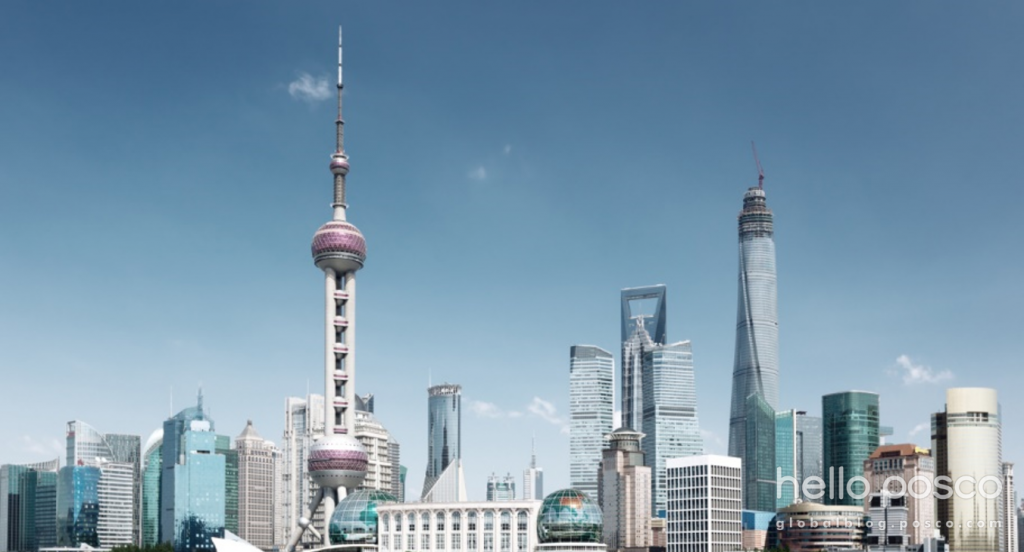Building these architectural feats brings both recognition and prestige to the cities where they are located. Even more critical is the development of urban space that is efficient and sustainable. Steel is a key material of building construction that will largely impact the progress of urbanization in the years to come.
Steel and Skyscrapers: A Brief History
The history of skyscrapers dates back to the second half of the 19th century when steel became a cornerstone of the world’s industrial economy. Steel framing and steel reinforced concrete made “curtain-wall” architecture possible, which led to the world’s first skyscrapers. Steel further evolved the capabilities of skyscrapers, allowing them to reach new heights. From the humble beginnings of the first skyscraper, the Home Insurance Building, built in Chicago in 1895 and standing 42m, skyscrapers now reach extraordinary heights.
Here are the four tallest skyscrapers in four of the regions of the world today.
Burj Khalifa, Dubai, Middle East
Rising to 829.8m over the gulf city of Dubai, the Burj Khalifa is the tallest building in the world. Designed by Skidmore Owings and Merill (SOM), the Burj Khalifa used a bundled tube design and a composite of steel and concrete to reach its record height. The Burj Khalifa employed a bundled tube system which is a system of construction that uses an interconnected frame of steel tubes. Thirty-nine thousand tons of steel rebar was needed for the construction. The Burj Khalifa houses a mix of residential, corporate and retail space.
Shanghai Tower, Shanghai, Asia
 Standing 632m, the 128-story Shanghai Tower is located in Shanghai’s financial district of Lujiazui, Pudong in China. Though currently still under construction, following its topping out in 2013, the Shanghai Tower is the tallest building in China and the second-tallest building in the world, surpassed only by the Burj Khalifa in Dubai. The Shanghai Tower is the tallest of a group of three adjacent supertall buildings in Pudong and is composed of three important design strategies, the asymmetry of the tower’s shape, its tapering profile and its rounded corners, all of which will allow it to withstand typhoon wind forces common in Shanghai.
Standing 632m, the 128-story Shanghai Tower is located in Shanghai’s financial district of Lujiazui, Pudong in China. Though currently still under construction, following its topping out in 2013, the Shanghai Tower is the tallest building in China and the second-tallest building in the world, surpassed only by the Burj Khalifa in Dubai. The Shanghai Tower is the tallest of a group of three adjacent supertall buildings in Pudong and is composed of three important design strategies, the asymmetry of the tower’s shape, its tapering profile and its rounded corners, all of which will allow it to withstand typhoon wind forces common in Shanghai.
One World Trade Center, New York, North America
 Designed by the same firm that designed the Burj Khalifa, the 104-story One World Trade Center reaches a height of 417m. Including the spire, its total height is 541m (1,776 ft.), a tribute to 1776, the year the U.S. won its independence. Surpassing the Willis Tower (formerly Sear’s Tower) in Chicago, the One World Trade Center is the tallest building in the U.S. The tower’s structure is designed around a strong, but lightweight, steel frame made of beams and columns. The lighter structures enabled savings in greenhouse gases and a 30 percent decrease in carbon emissions during construction. There are 70 elevators and nine escalators in the One World Trade Center. (Image: http://bit.ly/1DsqmBK)
Designed by the same firm that designed the Burj Khalifa, the 104-story One World Trade Center reaches a height of 417m. Including the spire, its total height is 541m (1,776 ft.), a tribute to 1776, the year the U.S. won its independence. Surpassing the Willis Tower (formerly Sear’s Tower) in Chicago, the One World Trade Center is the tallest building in the U.S. The tower’s structure is designed around a strong, but lightweight, steel frame made of beams and columns. The lighter structures enabled savings in greenhouse gases and a 30 percent decrease in carbon emissions during construction. There are 70 elevators and nine escalators in the One World Trade Center. (Image: http://bit.ly/1DsqmBK)
The Shard, London, European Union
 The Shard is a 72-story glass pyramid tower, rising above the city of London. It was completed in 2012, and stands 245m. The design uses an intelligent combination of steel and concrete. Steel structures were used from the ground floor to the 40th floor. From there to the 69th floor, concrete replaces the framing material, before the design reverts back to steel. Construction required 12,000 tons of steel.
The Shard is a 72-story glass pyramid tower, rising above the city of London. It was completed in 2012, and stands 245m. The design uses an intelligent combination of steel and concrete. Steel structures were used from the ground floor to the 40th floor. From there to the 69th floor, concrete replaces the framing material, before the design reverts back to steel. Construction required 12,000 tons of steel.
As the world continues to grow and urbanize the ability to adapt building structures and materials will continue to evolve. Steel will continue to be essential in helping the world’s buildings reach new heights.
The infographic below shows how each of these four gravity-defying structures compare. See how each stack up in height and the amount of steel necessary to make each possible. (Image: http://bit.ly/1eUAFTc)


